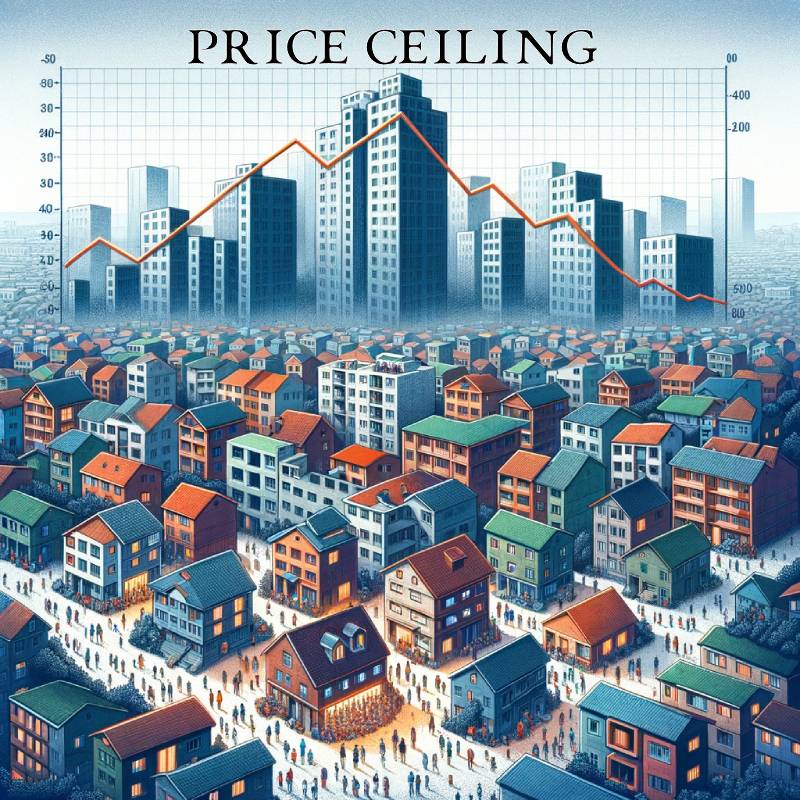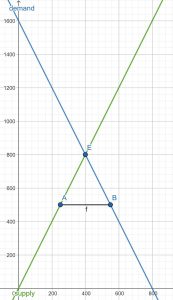The following hypothetical scenario discusses the supply and demand curves in the context of a shortage in the market for studio apartments.
In the realm of economics, supply and demand curves are utilized to represent the dynamics of a market, including the real estate market. According to the hypothetical scenario presented, there exists a shortage of studio apartments in the real estate market, influenced by rental prices. An equilibrium rental price is set at 800 euros, and we are asked to demonstrate the deficit at the price of 500 euros. The equilibrium rent signifies that at the price of 800 euros, supply and demand are equal, meaning there are enough tenants willing and able to pay 800 euros in rent for a property, and simultaneously, there are enough property owners willing to rent their properties at this price.
A probable diagram with hypothetical quantities for the number of studio apartments being offered or sought is presented (Diagram 1).
Diagram 1.
The diagram was constructed using the website https://www.geogebra.org/.
In this diagram, we initially observe the supply curve (supply). The supply curve represents the quantity of studio-type apartments (horizontal x-axis) that property owners are willing to rent out at various rental prices (vertical y-axis). In this case, the supply curve slopes upward from left to right, indicating that as the rental price increases, property owners are willing to offer more apartments. Conversely, the demand curve (demand) represents the quantity of such apartments that potential tenants are willing to rent at different rental prices. The demand curve slopes downward from left to right, suggesting that as the rental price decreases, more people are willing to rent apartments.
In Diagram 1, it is evident that at a rental price of 500 euros, the supply of studio apartments (point A) is considerably lower than the demand (point B). The line f represents the difference between the demanded and offered quantity for a rent of 500 euros. However, property owners are not willing to offer many apartments at this price, as it might not cover their expenses or yield a reasonable profit. This leads to a situation where the demanded quantity (by tenants) exceeds the offered quantity (by property owners), creating a shortage of studio-type apartments. Graphically, this is depicted by the triangle formed by points ABE, where E is the equilibrium point at 800 euros. At the equilibrium point E, the supply and demand curves intersect, indicating that the rental price and the corresponding quantity for this rent are common to both supply and demand. Property owners are willing to offer a certain quantity of apartments at this price, and tenants are willing to rent exactly this quantity. This represents a market equilibrium, where there is neither a surplus nor a shortage of studio apartments.
The shortage of studio apartments in the market, as described in the scenario, could be a result of a ‘price ceiling.’
A price ceiling is a government-imposed limit on the price charged for a product or service, for example, rental housing. Here’s how a price ceiling might lead to the shortage:
1. **Artificially Low Prices:** If the government sets a rental price ceiling that is below the market equilibrium (the price where supply equals demand), it results in artificially low rental prices. For instance, if the market equilibrium rent for a studio apartment is 800 euros, but the government caps rent at 500 euros, this creates a discrepancy, as in the hypothetical scenario above.
2. **Increased Demand:** Lower rental prices typically lead to an increase in demand. More people can afford to rent at the lower price, particularly those who might not have been able to afford the market rate. This includes students, young professionals, or low-income individuals looking for affordable housing options.
3. **Decreased Supply:** On the supply side, landlords may find it less profitable to rent out their properties at the lower, government-mandated prices. This could lead them to either withdraw their properties from the rental market (converting them to other more profitable uses) or not invest in maintaining or creating new rental properties. Consequently, the total number of studio apartments available for rent decreases.
4. **Quality Deterioration:** Additionally, with reduced rental income, landlords might reduce maintenance and investment in their properties, leading to a deterioration in the quality of the available housing.
5. **Market Imbalance:** The combination of increased demand and decreased supply creates a market imbalance. The quantity of studio apartments demanded at the lower price exceeds the quantity supplied, resulting in a shortage.
6. **Non-Price Rationing:** In such scenarios, non-price rationing mechanisms often emerge. For example, landlords might become more selective about tenants, or long waiting lists might develop for available apartments.
Therefore, while the intention behind a price ceiling is often to make housing more affordable, it can paradoxically lead to a shortage and reduce the overall quality and availability of housing in the market.


